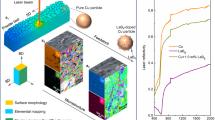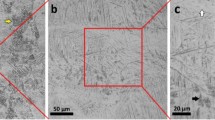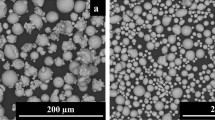Abstract
A new mechanical method for creating reactive laminate powders has been developed using a two-step process; in the first step bulk reactive materials are created by cold-rolling stacks of alternating sheets of nickel and aluminum into foils with bilayer thicknesses ranging from 2.9 to 1.8 μm. This step establishes the average reactant spacing and, hence, the reactivity of the material. In the second step the rolled foils are then ground into laminate powders and sieved based on their diameters, which range from 850 to 53 μm. Our processing methodology allows the particle size and the reactant spacing to be varied independently. Powders made by this method have heat releases within a differential scanning calorimeter (DSC) that vary with the average reactant spacing, similar to rolled and sputter deposited foils. However, the measured heats also vary with the average diameter of the powders, as smaller particles show a systematic decrease in heat. Furthermore, this effect is magnified for the powders with the coarsest microstructure, as they show the largest drop in DSC heat release. The physical densities also vary as a function of particle size. The powders with the largest average bilayer thickness become Ni-rich at the smallest particle sizes, powders with the next finest average bilayer thickness become Al-rich, and powders with the smallest average bilayer thickness show little variation. We attribute the particle size dependence of the DSC heats to small powders being broken from regions of the original rolled foils that contain a high volume fraction of Ni-rich and Al-rich bilayers. These microstructural and chemical variations alter the exothermic reactions that are seen during slow heating in a DSC, as well as the heats of reaction that are measured in the DSC as a function of powder size. We support this hypothesis of non-random breakup during grinding by simulating bimodal distributions of bilayer chemistry within powders and modeling their densities and heats of reaction. The simulations are compared with measured values. Finally, we normalize the effects of particle size and bilayer thickness by plotting the measured DSC heats of reaction versus the number of bilayers per particle; the values merge toward one curve, with the largest decrease in heat occurring when there are fewer than 150 bilayers in each particle. This ratio proves useful when selecting particles for particular applications.











Similar content being viewed by others
Referencess
Goldschmidt H (1908) New thermite reactions. Iron Age 82:232
Wang LL, Munir ZA, Maximov YM (1993) Thermite reactions: their utilization in the synthesis and processing of materials. J Mater Sci 28:3693–3708. doi:10.1007/BF00353167
Fischer SH, Grubelich MC (1996) A survey of combustible metals, thermites, and intermetallics for pyrotechnic applications. In: AIAA/ASME/SAE/ASEE joint propulsion conference proceedings, pp 1–15
Badiola C, Schoenitz M, Zhu X, Dreizin EL (2009) Nanocomposite thermite powders prepared by cryomilling. J Alloys Compd 488:386–391
Petrantoni M et al (2010) Multilayered Al/CuO thermite formation by reactive magnetron sputtering: nano versus micro. J Appl Phys 108:084323
Hunt EM, Pantoya ML (2005) Ignition dynamics and activation energies of metallic thermites: from nano- to micron-scale particulate Composites. J Appl Phys 98:034909
Umbrajkar SM, Schoenitz M, Dreizin EL (2006) Control of structural refinement and composition in Al–MoO3 nanocomposites prepared by arrested reactive milling. Propellants Explos Pyrotech 31:382–389
Pantoya ML, Hunt ME (2009) Nanochargers: energetic materials for energy storage. Appl Phys Lett 95:253101
Menon L et al (2004) Ignition studies of Al/Fe2O3 energetic nanocomposites. Appl Phys Lett 84:4735
Manesh NA, Basu S, Kumar R (2010) Experimental flame speed in multi-layered nano-energetic materials. Combust Flame 157:476–480
Eizadjou M, Kazemi Talachi A, Danesh Manesh H, Shakur Shahabi H, Janghorban K (2008) Investigation of structure and mechanical properties of multi-layered Al/Cu composite produced by accumulative roll bonding (ARB) process. Compos Sci Technol 68:2003–2009
Rossi C et al (2007) Nanoenergetic Materials for MEMS: a Review. J Electromech Syst 16:919–931
Tanaka S et al (2008) Test of B/Ti multilayer reactive igniters for a micro solid rocket array thruster. Sens Actuators A 144:361–366
Staley CS et al (2011) Silicon-based bridge wire micro-chip initiators for bismuth oxide–aluminum nanothermite. J Micromech Microeng 21:115015
Weihs TP (2013) Fabrication and characterization of reactive multilayer films and foils. In: Barmak K, Coffey KR (eds) Metallic films for electronic, magnetic, optical and thermal applications: structure, processing and properties, chap 6. Woodhead Publishing, Swaston
Floro JA (1986) Propagation of explosive crystallization in thin Rh–Si multilayer films. J Vac Sci Technol 4:631
Gavens AJ, Van Heerden D, Mann AB, Reiss ME, Weihs TP (2000) Effect of intermixing on self-propagating exothermic reactions in Al/Ni nanolaminate foils. J Appl Phys 87:1255–1263
Ma E, Thompson CV, Clevenger LA, Tu KN (1990) Self-propagating explosive reactions in Al/Ni multilayer thin films. Appl Phys Lett 57:1262
Anselmi-Tamburini U, Munir ZA (1989) The propagation of a solid-state combustion wave in Ni–Al foils. J Appl Phys 66:5039
Wickersham CE (1988) Explosive crystallization in zirconium/silicon multilayers. J Vac Sci Technol 6:1699
Dyer TS, Munir ZA, Ruth V (1994) The combustion synthesis of multilayer NiAl systems. Scr Metall Mater 30:1281–1286
Reiss ME et al (1999) Self-propagating formation reactions in Nb/Si multilayers. Mater Sci Eng A 261:217–222
Morsi K (2012) The diversity of combustion synthesis processing: a review. J Mater Sci 47:68–92. doi:10.1007/s10853-011-5926-5
Eakins D, Thadhani N (2012) Shock compression of reactive powder mixtures. Int Mater Rev 54:181–213
Sieber H, Wilde G, Perepezko J (1999) Thermally activated amorphous phase formation in cold-rolled multilayers of Al–Ni, Al–Ta, Al–Fe and Zr–Cu. J Non Cryst Solids 250–252:611–615
Sieber H, Park JS, Weissmüller J, Perepezko JH (2001) Structural evolution and phase formation in cold-rolled aluminum–nickel multilayers. Acta Mater 49:1139–1151
Hebert RJ, Perepezko JH (2004) Deformation-induced synthesis and structural transformations of metallic multilayers. Scr Mater 50:807–812
Saito Y, Utsunomiya H, Tsuji N, Sakai T (1999) Novel ultra-high straining process for bulk materials development of the accumulative roll-bonding (ARB) process. Acta Mater 47:579–583
Mozaffari A, Manesh HD, Janghorban K (2010) Evaluation of mechanical properties and structure of multilayered Al/Ni composites produced by accumulative roll bonding (ARB) process. J Alloys Compd 489:103–109
Qiu X et al (2009) Combustion synthesis reactions in cold-rolled Ni/Al and Ti/Al multilayers. Metall Mater Trans A 40:1541–1546
Chowdhury S, Sullivan K, Piekiel N, Zhou L, Zachariah MR (2010) Diffusive versus explosive reaction at the nanoscale. J Phys Chem C 114:9191–9195
Rai A, Park K, Zhou L, Zachariah MR (2006) Understanding the mechanism of aluminium nanoparticle oxidation. Combust Theor Model 10:843–859
Jian G, Chowdhury S, Sullivan K, Zachariah MR (2013) Nanothermite reactions: is gas phase oxygen generation from the oxygen carrier an essential prerequisite to ignition? Combust. Flame 160:432–437
Salloum M, Knio OM (2010) Simulation of reactive nanolaminates using reduced models: III. Ingredients for a general multidimensional formulation. Combust Flame 157:1154–1166
Salloum M, Knio OM (2010) Simulation of reactive nanolaminates using reduced models: I. Basic formulation. Combust Flame 157:288–295
Salloum M, Knio OM (2010) Simulation of reactive nanolaminates using reduced models: II. Normal propagation. Combust Flame 157:436–445
Mann AB et al (1997) Modeling and characterizing the propagation velocity of exothermic reactions in multilayer foils. J Appl Phys 82:1178
Alawieh L, Knio OM, Weihs TP (2011) Effect of thermal properties on self-propagating fronts in reactive nanolaminates. J Appl Phys 110:013509
Jayaraman S, Knio OM, Mann AB, Weihs TP (1999) Numerical predictions of oscillatory combustion in reactive multilayers. J Appl Phys 86:800
Bockmon BS, Pantoya ML, Son SF, Asay BW, Mang JT (2005) Combustion velocities and propagation mechanisms of metastable interstitial composites. J Appl Phys 98:064903
Pantoya M, Granier J (2005) Combustion behavior of highly energetic thermites: nano versus micron composites. Propellants Explos Pyrotech 30:53–62
Knepper R et al (2009) Effect of varying bilayer spacing distribution on reaction heat and velocity in reactive Al/Ni multilayers. J Appl Phys 105:083504
Besnoin E, Cerutti S, Knio OM, Weihs TP (2002) Effect of reactant and product melting on self-propagating reactions in multilayer foils. J Appl Phys 92:5474
Rogachev AS et al (2004) Gasless combustion of Ti–Al bimetallic multilayer nanofoils. Combust Explos Shock Waves 40:166–171
Rogachev AS (2008) Exothermic reaction waves in multilayer nanofilms. Russ Chem Rev 77:21–37
Bazyn T et al (2007) Reflected shock ignition and combustion of aluminum and nanocomposite thermite powders. Combust Sci Technol 179:457–476
Stamatis D, Jiang X, Beloni E, Dreizin EL (2010) Aluminum burn rate modifiers based on reactive nanocomposite powders. Propellants Explos Pyrotech 35:260–267
Morsi K (2001) Review: reaction synthesis processing of Ni–Al intermetallic materials. Mater Sci Eng A 299:1–15
Fritz GM, Joress H, Weihs TP (2011) Enabling and controlling slow reaction velocities in low-density compacts of multilayer reactive particles. Combust Flame 158:1084–1088
Michaelsen C, Barmak K, Weihs TP (1997) Investigating the thermodynamics and kinetics of thin film reactions by differential scanning calorimetry. J Phys D 30:3167–3186
Stover AK et al (2013) An analysis of the microstructure and properties of cold-rolled Ni:Al laminate foils. J Mater Sci 48:5917–5929
Boer RF, Boom R, Mattens WCM, Miedema AR, Niessen AK (1988) Cohesion in metals. Elsevier, Amsterdam
Acknowledgments
The authors are grateful to Mark Koontz for his help in acquiring the SEM images. This work was supported by the Office of Naval Research through Award N00014-07-1-0740. TPW and AKS are inventors of a related technology that has been licensed by Johns Hopkins University and the Indium Corporation of America. The terms of this arrangement are being managed by Johns Hopkins University in accordance with its conflict of interest policies.
Author information
Authors and Affiliations
Corresponding author
Rights and permissions
About this article
Cite this article
Stover, A.K., Krywopusk, N.M., Gibbins, J.D. et al. Mechanical fabrication of reactive metal laminate powders. J Mater Sci 49, 5821–5830 (2014). https://doi.org/10.1007/s10853-014-8187-2
Received:
Accepted:
Published:
Issue Date:
DOI: https://doi.org/10.1007/s10853-014-8187-2




